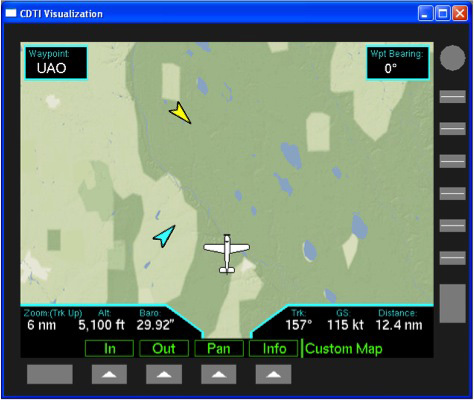Engineers Find Way to Lower Risk of Midair Collisions for Small Aircraft

A modified screen display helps pilots identify which plane poses the greatest risk to their flight path. Image: Carl Pankok.
At issue are “cockpit displays of traffic information” (CDTIs). These are GPS displays used by private pilots to track other aircraft in their vicinity. However, pilots often focus on the closest aircraft on the display – a habit that can pose a significant hazard.
If the pilot of Plane A sees two planes on the CDTI, he’s more likely to focus on the closest aircraft (Plane B). But if the more distant plane (Plane C) is moving at high speed, it could cross his path before Plane B does. Not paying enough attention to Plane C increases risk of a midair collision.
“Our goal was to modify a CDTI to help pilots recognize which other planes pose the greatest risk,” says Carl Pankok, lead author of a study on the work and a Ph.D. student in the Edward P. Fitts Department of Industrial and Systems Engineering at NC State. “And it worked.”
Researchers modified the CDTI so that the plane that would cross a pilot’s path first either began blinking or was colored yellow.
The researchers tested the modified CDTI in a flight simulator with a panel of licensed recreational pilots. The research team compared the pilots’ response times and decision-making accuracy when using the modified and unmodified displays.
“These pilots were already pretty good, but the modified CDTIs made them better,” Pankok says. “Their percentage of ‘correct’ decisions – minimizing risk – jumped from 88 percent to 96 percent. And their response times in scenarios where the farther aircraft was the higher-risk aircraft were cut in half; from 7.2 seconds to 3.7 seconds for blinking CDTIs, and to 4 seconds for yellow CDTIs.
“We’re not trying to make money off this,” Pankok says. “We’re hoping that CDTI manufacturers can incorporate these changes and possibly save lives.”
The paper, “Cockpit Displays of Traffic Information and Pilot Bias in Time-to-Contact Judgments,” is published in the June issue of Aviation, Space, and Environmental Medicine. Senior author of the paper is Dr. David Kaber, a professor in the Edward P. Fitts Department of Industrial and Systems Engineering at NC State. The work was supported by the U.S. National Institute for Occupational Safety and Health under grant No.2 T42 OH008673-08.
-shipman-
Note to Editors: The study abstract follows.
“Cockpit Displays of Traffic Information and Pilot Bias in Time-to-Contact Judgments”
Authors: Carl Pankok, Jr. and David B. Kaber, North Carolina State University
Published: June 2014, Aviation, Space, and Environmental Medicine
Abstract: Introduction: Pilots are susceptible to over-reliance on distance when making relative time-to-contact (TTC) judgments of surrounding intruders, referred to as “the distance bias.” We tested the effect of adding perceptual cues and an information feature to cockpit displays of traffic information to mitigate this bias. Method: Fourteen general aviation pilots participated in a simulated flight scenario and were asked to make relative TTC judgments. Three levels of perceptual cue (blinking, color-change, and no-cue) were crossed with two levels of velocity data tag (present and absent) with identification of the highest risk intruder as a response. Results: Perceptual cues were associated with more accurate high-risk intruder selection (color=95.95% correct, blinking= 95.98%, no-cue=87.89%), decreased response time (color=3.68 sec, blinking= 3.19 sec no-cue=6.08 sec), reduced visual attention demand (color=57% of attention, blinking= 58%, no-cue=62%), lower workload ratings (color=28.38/100, blinking= 29.66/100, no-cue=48.91/100), and higher performance confidence ratings (color=83.92/100, blinking=82.71/100, no-cue=58.85/100) than the no-cue displays. There was no difference between blinking and color cue displays. The data tag was associated with lower response times (present=4.13 sec, absent=4.50 sec) and higher confidence ratings (present=78.69/100, absent=71.63/100) than displays without. Displays including the blinking cue, color-change cue, and data tag were preferred over displays that did not include these features (color=8 pilots, blinking=6, no-cue=0). Discussion: The added display features were effective in mitigating the effect of the distance bias on pilot performance measures and received favorable subjective ratings.
Media Contact
More Information:
http://news.ncsu.edu/releases/pankok-flight-2014/All latest news from the category: Transportation and Logistics
This field deals with all spatial and time-related activities involved in bridging the gap between goods and people, including their restructuring. This begins with the supplier and follows each stage of the operational value chain to product delivery and concludes with product disposal and recycling.
innovations-report provides informative reports and articles on such topics as traffic telematics, toll collection, traffic management systems, route planning, high-speed rail (Transrapid), traffic infrastructures, air safety, transport technologies, transport logistics, production logistics and mobility.
Newest articles

Machine learning algorithm reveals long-theorized glass phase in crystal
Scientists have found evidence of an elusive, glassy phase of matter that emerges when a crystal’s perfect internal pattern is disrupted. X-ray technology and machine learning converge to shed light…

Mapping plant functional diversity from space
HKU ecologists revolutionize ecosystem monitoring with novel field-satellite integration. An international team of researchers, led by Professor Jin WU from the School of Biological Sciences at The University of Hong…

Inverters with constant full load capability
…enable an increase in the performance of electric drives. Overheating components significantly limit the performance of drivetrains in electric vehicles. Inverters in particular are subject to a high thermal load,…





















